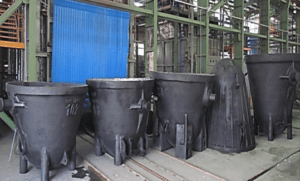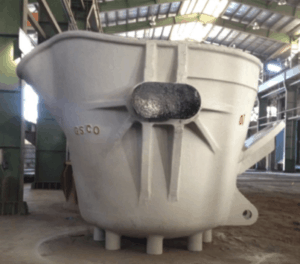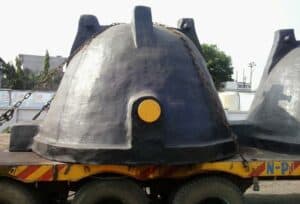Slag Pots
» Products » Metal Production » Slag Pots
The slag pots are wearing products exposed to both mechanical and alternate thermal stresses the extent of them depends on the service conditions. An accurate design aims to minimize the impair of the operative environment on the service life: however, it remains always a compromise taking into consideration both physical and economical aspects, resulting in a variety of shapes tailored to the site operations.
A comprehensive data bank containing previous experiences combined with advanced software implementing the Finite Element Analysis serves custom engineered design optimization. Our company offers the slag pots made out of cast-steel with the capacity up to 45m3. We possess extensive experience based upon engineering and production of more than 3.000 slag pots over the recent 20 last years, partially in cooperation with manufacturers of slag pots carriers and service providers to metallurgical industries. The slag pots delivered by our company are operated worldwide wherever reliable tools are required for the disposal of molten or solid slag which arises from metallurgical or chemical processes.
Material
The slag pots are made out of vacuum degassed cast steel, processed to a fine grain size structure with improved properties both in toughness and in elongation.
The mechanical properties are checked at a room temperature in the delivery condition i.e. after completion of the quality heat treatment from cylindrical cast-on test blocks (Ø 60mm x 250mm) available on every slag pot: both sampling preparation and the testing comply with ASTM A 370-96.
Production of Slag Pots
Moulding: Moulding is performed within a modular flask by using a sand preparation based on resin bonding.
Trunnions: Trunnions – when any – are preferably cast-in: basically they are manufactured from steel grade S355 J2G3 acc. to DIN EN 10250-2 and forged as per DIN 7527. Cast-on and hot-fitted trunnions can also be provided.
Melting: Melting is carried out in the oxygen steel plant (2 off 180 MT BOF converters); the ladle capacity allows a continuous bottom pouring process with fully monitored and controlled speed. The metal analysis is checked by using a computed linked spectrograph.
Heat treatment: Every pot undergoes a combined quality heat treatment (annealing) aiming both to grain refining and stress relieving i.e.:
Heating to a temperature above AR3, austenitising at about 915oC and controlled cooling in furnace,
Intermediate holding at 600oC-630oC and completion of cooling in furnace down to 300oC.
Fettling and dressing
The inner surface is processed fit-to-purpose, eliminating surface irregularities, which might cause some sticking of the slag. In addition, the castings are descaled by shot-blasting and the outside is additionally coated for transportation.
Quality assurance
Engineering and production are in compliance with our Quality System ISO 9001 : 2000.
- The standard documentation ensures the full traceability of every process step:
- Manufacturer test certificates according to DIN EN 10.204 § 3.1 including chemical composition, mechanical properties and non-destructive examination;
- Dimensional check supported with a “as-built” sketch;
- Record of the quality heat treatment.



